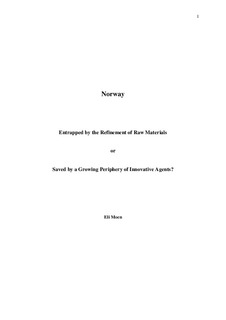| dc.contributor.author | Moen, Eli | |
| dc.date.accessioned | 2010-05-07T11:50:56Z | |
| dc.date.available | 2010-05-07T11:50:56Z | |
| dc.date.issued | 2009 | |
| dc.identifier.citation | Published in: Kristensen and Lilja (eds), New modes of globalizing: experimentalist forms of economic organization and enabling welfare institutions, Helsinki School of Economics, 2009. | en_US |
| dc.identifier.isbn | 9789524883092 | |
| dc.identifier.uri | http://hdl.handle.net/11250/93318 | |
| dc.description.abstract | Norway is performing remarkably well. For several years in a row the United Nations has named Norway the best country in the world to live in (Human Development Reports). The population enjoys one of the highest levels of GDP per capita, an egalitarian distribution of wealth, and generous welfare state arrangements. Yet, Norway is trailing the other Nordic countries in terms of economic dynamism. On the World Economic Forum’s ranking lists, Norway has been ranked lowest among the Nordic countries and has most recently dropped significantly behind. The country is ranked very low on international innovation scoreboards (cf. EIS), is blamed for investing too little in R&D, less than 1.7 per cent of GDP which is well below the OECD average, and is less integrated into the globalized economy than the other Nordic countries. Are these indicators symptoms of a nation about to be trapped by the paradox of plenty? Has Norway failed to sustain and develop a dynamic and competitive economy for future challenges? | en_US |
| dc.language.iso | eng | en_US |
| dc.publisher | Helsinki School of Economics | en_US |
| dc.title | Norway: Entrapped by the refinement of raw materials or saved by a growing periphery of innovative agents? | en_US |
| dc.type | Journal article | en_US |
| dc.type | Peer reviewed | en_US |
